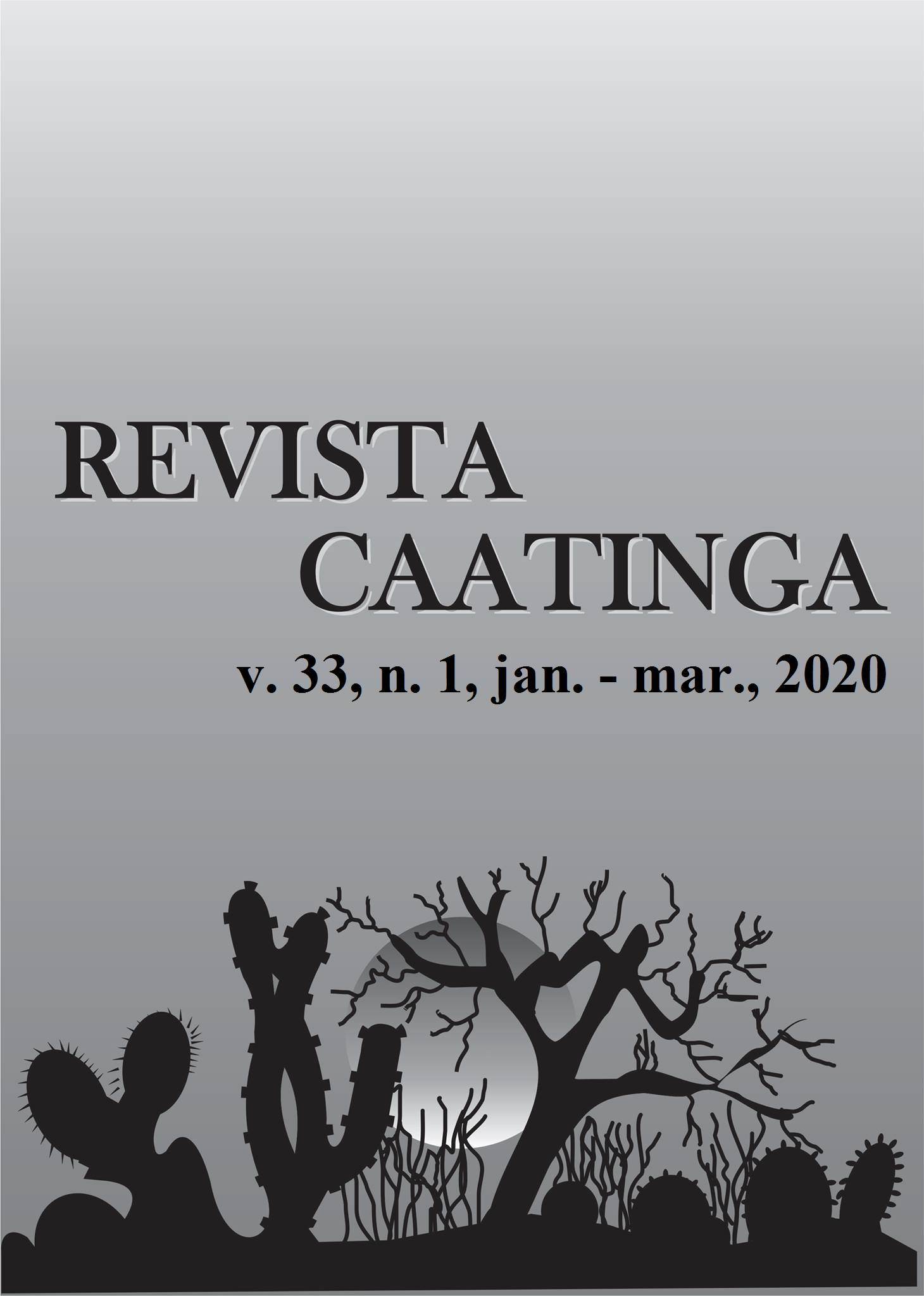GROWTH ENVIRONMENT AND POT VOLUME AFFECT BIOMASS AND ESSENTIAL OIL PRODUCTION OF BASIL
DOI:
https://doi.org/10.1590/1983-21252020v33n115rcKeywords:
Aromatic plant. Shading. Colored screens.Abstract
The objective of this work was to evaluate the effect of pot volume and growth environment on the productions of biomass and essential oil of basil plants (Ocimum basilicum L.). A completely randomized experimental design was used, with five replications, in a 6×2 factorial arrangement consisting of 6 growth environments (full sun; 50% black shade screen; 50% silver shade screen; 50% red shade screen; 35% green shade screen; 150 µm low density polyethylene film - LDPE) and two pot volumes (3.5 L and 5.0 L). The plants were cut and evaluated for variables related to growth, root system, and extraction of essential oil. The growth environments and pot volumes affected the production of biomass and essential oil of the basil plants evaluated. Plants grown under red and silver shade screens had 36.03% and 31.31% higher plant height than those grown at full sun, respectively. Basil plants grown in 5.0-liter pots under black shade screen produced higher essential oil contents. The biomass production of basil plants grown in 5.0-liter pots was affected by the red and green shade screens and LDPE film. The growth of basil plants in 5.0-liter pots under 50% black shade screen is recommended when the crop is intended for essential oil extraction; and their growth in 5.0-liter pots under red shade screen, green shade screen, or LDPE film is recommended when the crop is intended for fresh biomass production.
Downloads
References
ALMEIDA, M. O. et al. Influência do tamanho do vaso e época de avaliação sobre o crescimento do picão preto em competição com milho e soja. Original Article Uberlandia, 30: 1428-1437, 2014.
BLANK, A. F. et al. Maria Bonita: cultivar de manjericão tipo linalol. Pesquisa Agropecuária Brasileira, 42: 1811-1813, 2007.
BRANT, R. S. et al. Crescimento, teor e composição do óleo essencial de melissa cultivada sob malhas fotoconversoras. Ciência Rural, 39: 1401-1407, 2009.
BRUM, B. et al. Crescimento, duração do ciclo e produção de inflorescências de crisântemo multiflora sob diferentes números de despontes e tamanhos de vasos. Ciência Rural, 37: 682-689. 2007.
CAMPOS, G. E. C.; MENDONÇA, G. L. Influência do tamanho do vaso no desenvolvimento do manjericão doce em condição de estufa. 2013. Faculdade de Agronomia e Medicina Veterinária, Universidade de Brasília. Monografia de graduação. Brasília-DF. 2013.
CHAGAS, J. H. et al. Produção, teor e composição química do óleo essencial de hortelã-japonesa cultivada sob malhas fotoconversoras. Horticultura Brasileira, 31: 297-303, 2013.
CORRÊA, R. M. et al. Crescimento de plantas, teor e qualidade de óleo essencial de folhas de orégano sob malhas coloridas. Global Science Technology, 5: 11-22, 2012.
ERENO, D. Perfume de manjericão. Revista Fapesp, 12: 25-28, 2006.
FERREIRA, D. F. Sisvar: a computer statistical analysis system. Ciência e Agrotecnologia, 35: 1039-1042, 2011.
GENUNCIO, G. C. et al. Manjericão roxo tem demanda garantida. Campo e negócios hortifrúti, 54: 42-47, 2018.
GOMES, P. A. et al. Influência do sombreamento na produção de biomassa, óleo essencial e quantidade de tricomas glandulares em cidrão (Lippia citriodora Lam.). Biotemas, 22: 9-14, 2009.
HOAGLAND, D. R.; ARNON, D. I. The water culture method for growing plants without soils. California Agricultural Experimental Station. Circular 347. Berkeley. 1950. 32 p.
JONES, R. H.; MCLEOD, K. W. Responses to a range of light environments in Chinese Tallowtree and Carolina Ash seedlings. Forest Science, 36: 851-862, 1990.
LARCHER, W. Ecofisiologia vegetal. 1 ed. São Carlos, SP: RiMA Artes e Textos, 2004. 531 p.
LIMA, J. D. et al. Efeitos da luminosidade no crescimento de mudas de Caesalpinia ferrea Mart. Ex Tul. (Leguminosae, Caesalpinoideae). Acta Amazônica, 38: 5-10, 2008.
LUZ, J. M. Q. et al. Produção de óleo essencial de Ocimum basilicum L. em diferentes épocas, sistemas de cultivo e adubações. Boletín Latinoamericano y del Caribe de Plantas Medicinales y Aromáticas, 13: 69-80, 2014.
MARTINS, J. R. et al. Avaliação do crescimento e teor de óleo essencial em plantas de Ocimum grantissimum L. cultivadas sob malhas coloridas. Revista Brasileira de Plantas Medicinais, 10: 102-107, 2008.
OLIVEIRA, M. I. et al. Características biométricas, anatômicas e fisiológicas de Artemisia vulgaris L. cultivada sob telas coloridas. Revista Brasileira de Plantas Medicinais, 11: 56-62, 2009.
POORTER, H. et al. Pot size matters: a meta-analysis of the effects of rooting volume on plant growth. Functional Plant Biology, 39: 839-850, 2012.
SOUZA, G. S. et al. Crescimento, produção de biomassa e aspectos fisiológicos de plantas de Mentha piperita L. Cultivadas sob diferentes doses de fósforo e malhas coloridas. Global Science Technology, 6: 35-44, 2013.
SOUZA, G. S. et al. Crescimento, teor de óleo essencial conteúdo de cumarina de plantas jovens de guaco (Mikania glomerata Sprengel) cultivadas sob malhas coloridas. Revista Biotemas, 24: 1-11, 2011.
SOUZA, G. S. et al. Crescimento vegetativo e produção de óleo essencial de plantas de alecrim cultivadas sob telas coloridas. Bioscience Journal, 30: 232-239, 2014.
TAIZ, L.; ZEIGER, E. Fisiologia e desenvolvimento vegetal. 6. ed. Porto Alegre, RS: Artmed, 2015. 888 p.
Downloads
Published
Issue
Section
License
Os Autores que publicam na Revista Caatinga concordam com os seguintes termos:
a) Os Autores mantêm os direitos autorais e concedem à revista o direito de primeira publicação, com o trabalho simultaneamente licenciado sob a Licença Creative Commons do tipo atribuição CC-BY, para todo o conteúdo do periódico, exceto onde estiver identificado, que permite o compartilhamento do trabalho com reconhecimento da autoria e publicação inicial nesta revista, sem fins comerciais.
b) Os Autores têm autorização para distribuição não-exclusiva da versão do trabalho publicada nesta revista (ex.: publicar em repositório institucional ou como capítulo de livro), com reconhecimento de autoria e publicação inicial nesta revista.
c) Os Autores têm permissão e são estimulados a publicar e distribuir seu trabalho online (ex.: em repositórios institucionais ou na sua página pessoal) a qualquer ponto antes ou durante o processo editorial, já que isso pode gerar alterações produtivas, bem como aumentar o impacto e a citação do trabalho publicado (Veja O Efeito do Acesso Livre).







